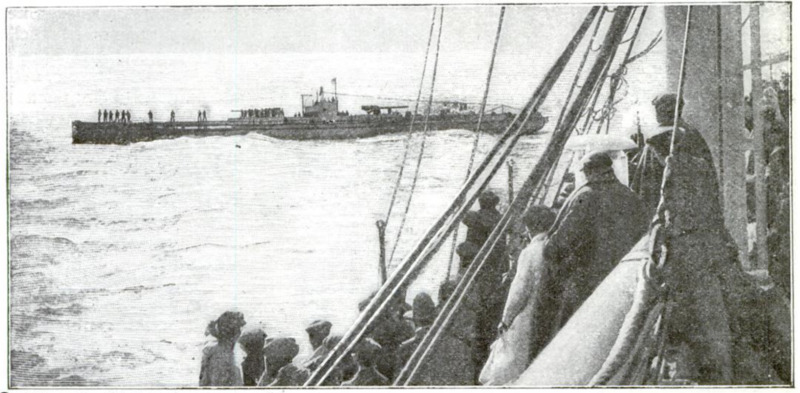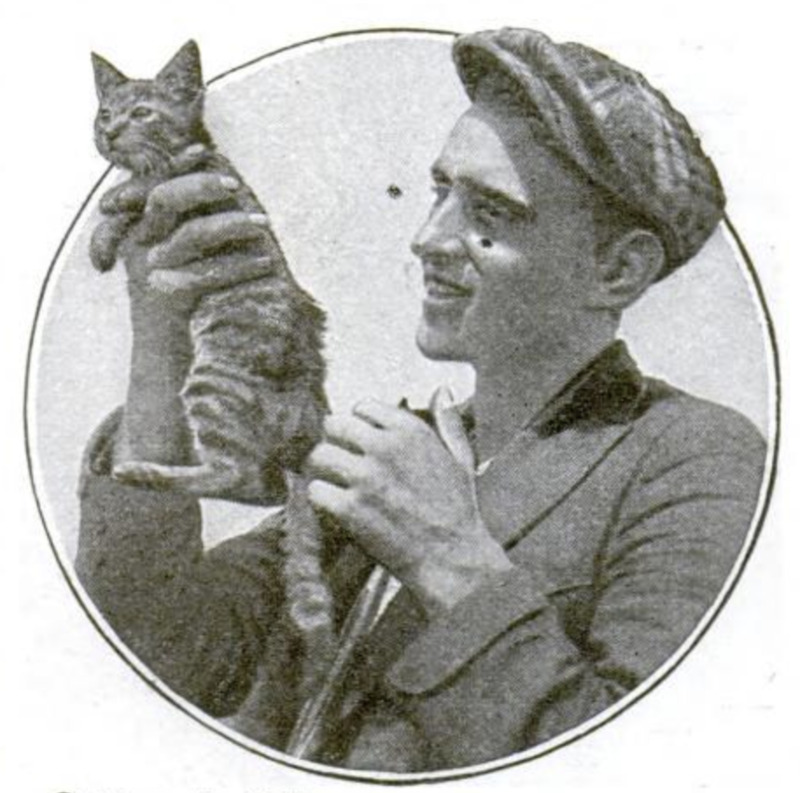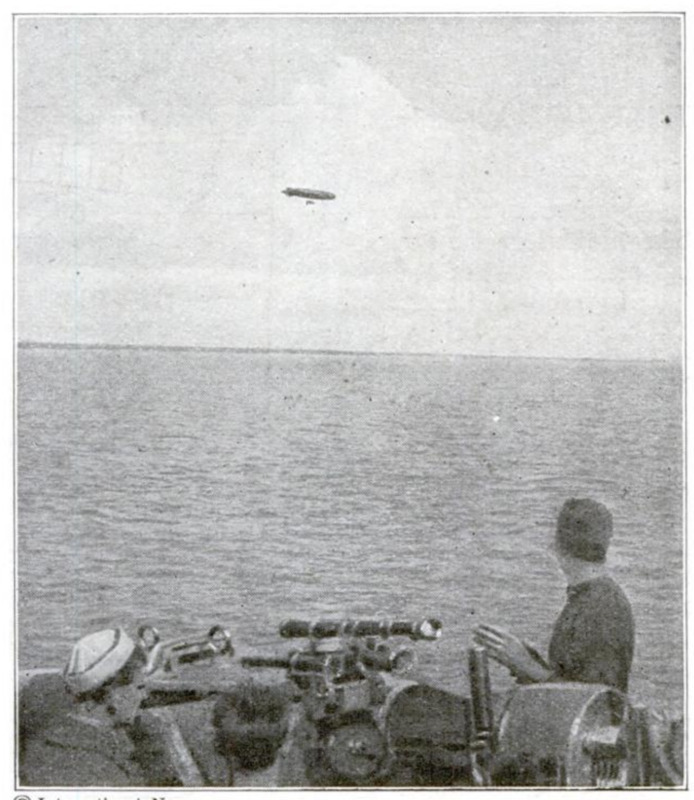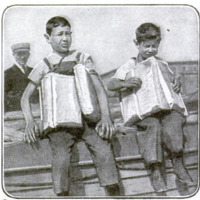-
Titolo
-
German U-53
-
Article Title and/or Image Caption
-
Terrorizing Our Atlantic Seaboard. Depth-bombs, nets, mines, destroyers, and seaplanes have not exterminated the pest of the seas nor kept it at home. How can America protect herself?
-
extracted text
-
ALTHOUGH the U-53 voyaged across
the Atlantic, slipped in and out of
Newport and then sank half a
dozen ships off Nantucket at a time when
we were still neutral, although the
Deutschland made two highly successful
and profitable visits to these shores, the
recent attacks of submarines on ships off
the Atlantic coast amazed us with their
dramatic suddenness. But, then, sur-
prise is the very essence of the U-boat’s
methods. A full week elapsed before
the Government was aware of the first
sinking. The American public naturally
asks itself : What can be done to stop
the Germans?
Dernburg, of unsavory memory, re-
cently announced that the average cargo
is worth $175 a ton and that it costs $250
to supply each new ton of shipping. At
this rate, estimates the English naval
critic, Arthur Pollen, the submarine war
has already cost the anti-German world
over $6,150,000,000. In four years
about 22,000,000 tons of shipping have
been lost.
In the third year of the war, by which
time it might be concluded that the
various methods devised for coping with
the submarine would have been made
truly effective, about three million tons
were sent to the bottom.
And what is the remedy proposed to
offset this continuing loss? To build
ships faster than the U-boats can sink
them. To me nothing is more ridiculous.
Even admitting that all the tonnage re-
quired can be produced in the way of
surface ships, it must also be admitted
that to do so entails the employment of
thousands of workmen and thousands of
tons of material required for other pur-
poses. A crumb of comfort is found in
the fact that the sinkings are not quite so
numerous as they were two years ago.
There are fewer ships to sink. Besides,
captains are more cautious than they
were, and nets and patrols count for some-
thing, however little. It remains to be seen
if there will not be a marked increase in
the sinkings as soon as the new ships
that we are building are commissioned.
Submarines Are Not Easily Sunk
How many submarines have been sunk
since September,
1914? No one knows.
But despite every-
thing, the most opti-
mistic compiler of sta-
tistics would not place
the number at more
than one hundred.
Commander Taussig of
our navy recently said
thet “a submarine is a
very difficult bird to
catch.” He had him-
self engaged only one
U-boat in seven months
and was not sure that
he had sunk any.
Submerged, a subma-
rine must keep moving
or else must rest on the bottom; and this
last is impossible except in depths which
are less than two hundred feet. Now the
Atlantic seaboard is literally made for con-
cealing submarines. Taken as a whole, it
is a long stretch of sand which slopes out
into the ocean very gently. Within a
hundred miles off the coast the subma-
rine can find a resting place that is ideal.
Those who place their reliance on sea-
planes and dirigibles to detect a sub-
merged submarine know little of the
difficulties that confront the observer in
the air. Itis only in still, clear water that
a U-boat can be seen beneath the surface.
In even moderately rough water nothing
is visible; and the water is usually more
than moderately rough. Moreover, let
it not be forgotten that many long hours
elapsed before one of the lifeboats cruelly
set adrift by the Germans after sinking a
ship off our coast was picked up; no sea-
plane had helped in her recovery.
A U-Boat Needs No American Base
‘We read much nonsense about mysteri-
ous U-boat bases on the Atlantic coast.
No land base is necessary. A German
submarine of the latest cruiser-type is of
about two thousand tons displacement
and is about two hundred and fifty feet
long. Her carrying capacity ie easily six
hundred tons. Suppose that four hundred
tons of fuel-oil are taken on board, one
hundred tons of shells, bombs and tor-
pedoes, and one hundred tons of food.
With such a supply of stores she could
prowl in our waters for many weeks, and
even for months. She
would husband her fuel,
jogging along at about
ten knots, as a rule, and
attaining a maximum
of fourteen only when
she is bent on over-
hauling a fleeing ship.
If a base were necessary
an out-and-out subma-
rine cargo-carrier of the
Deutschland type would
answer all purposes.
There is but one rem-
edy, in my opinion, and
that is to pit submarine
against submarine.
Build submersible car-
go-carriers, like the
Deutschland, and the Allies may snap
their fingers at the U-boat. I have advo-
cated the plan in the POPULAR SCIENCE
MONTHLY, and in other publications. It
is unnecessary to repeat the details.
Since I wrote for the POPULAR SCIENCE
MonTHLY I have studied the subject
further. I have even designed a subma-
rine cargo-carrier according to the specifi-
cations of Lloyd’s—specifications which
are followed the world over in building
surface ships. To my astonishment the
resulting vessel proves to be far stronger
than I had imagined. It would actually
be able to withstand submergence to a
depth of eight
hundred feet
without col-
lapsing. No
submarine of
the present day
could descend
so far in safety.
The Armored
Submarine of
the Future
Now that its
radius of action
has been so tre-
mendously in-
creased the sub-
marine prob-
lem becomes
more difficult of
solution. The
mid - Atlantic
becomes as
dangerous as
the waters sur-
rounding Great
Britain.
The new Ger-
man diving
cruisers carry
5.9in. guns and
can fight. We read almost every day
of engagements between armed merchant-
men and U-boats. In other words, the
submarine does not even have to sub-
merge in order to escape. Safety is now
sought beneath the waves only in desper-
ate situations. As for the many patrol
vessels that swarm in European and
American waters, most of them are too
slow and too lightly armed to be of any
real value. Thus, it is said that the Ford
submarine chasers are to be armed with
only four-inch guns.
What Von Tirpitz Wanted
‘We have here some indication of what
the future holds forth. U-boats will un-
questionably be armored; they will carry
heavier guns; they will be larger; they
will be faster.
If I know anything of the German
mind and of German technical boldness
—and I may lay claim to some such
knowledge in view of my past relations
with the German navy and with the
Krupp works—the Germans are not un-
likely to pro-
duce an ar-
mored sub-
mersible dur-
ing the present
war, if it lasts
much longer.
About twelve
years ago, at a
time when I
was asked by
the Krupps to
rectify some er-
rors that had
been made by
them in build-
ing submarines
for the Russian -
government, I
met the re-
doubtable Ad-
miral von Tir- *
pitz. I showed |
him the plans .
for two sub-
marines — one
a defensive
type, the other
an offensive
type. The
offensive type
had an armored gun turret such as I am
now advocating. When von Tirpitz
saw the blueprints of the offensive type,
he brushed aside the plans of the other
and said: “This is what we want.”
At that time the Navy Department of
the United States was taking a rather
lukewarm interest in submarines and had
not made up its mind in what particular
niche the submarine fitted. But von
Tirpitz, father of the German navy, von
Tirpitz, the advocate of ruthless sub-
marine warfare, saw the possibilities at
once and displayed interest in a type
about which our own officers are still
skeptical. It is not likely that he has
forgotten his desire for a craft which
would be a kind of submersible battle-
ship and which would be able to take its
place lined up with dreadnoughts.
-
Autore secondario
-
Simon Lake (writer)
-
Underwood and Underwood (photo)
-
International Film (photos)
-
International News (photo)
-
Lingua
-
eng
-
Data di rilascio
-
1918-08
-
pagine
-
207-209
-
Diritti
-
Public Domain (Google digitized)
-
Archived by
-
Filippo Valle
-
Alberto Bordignon (Supervisor)








